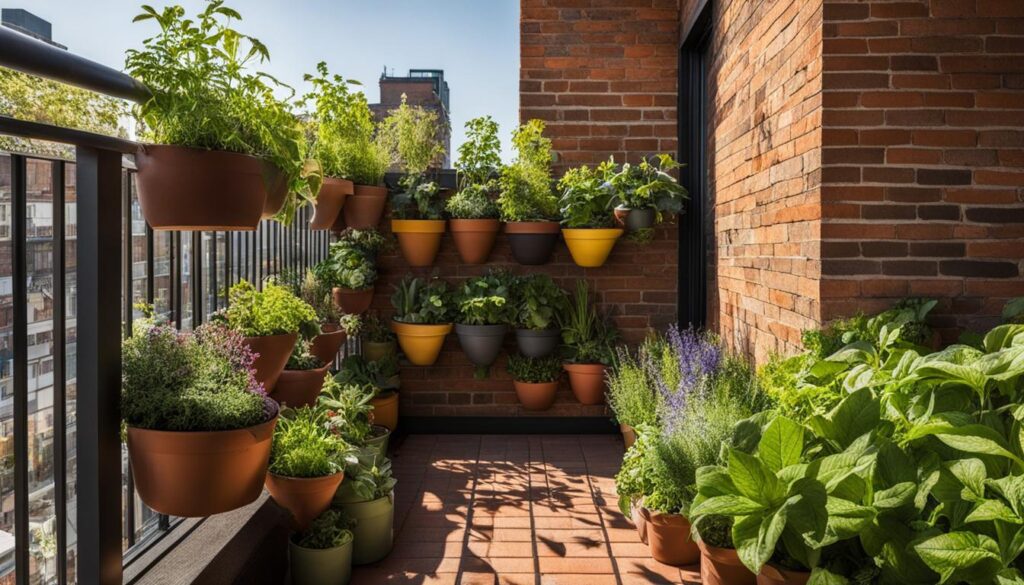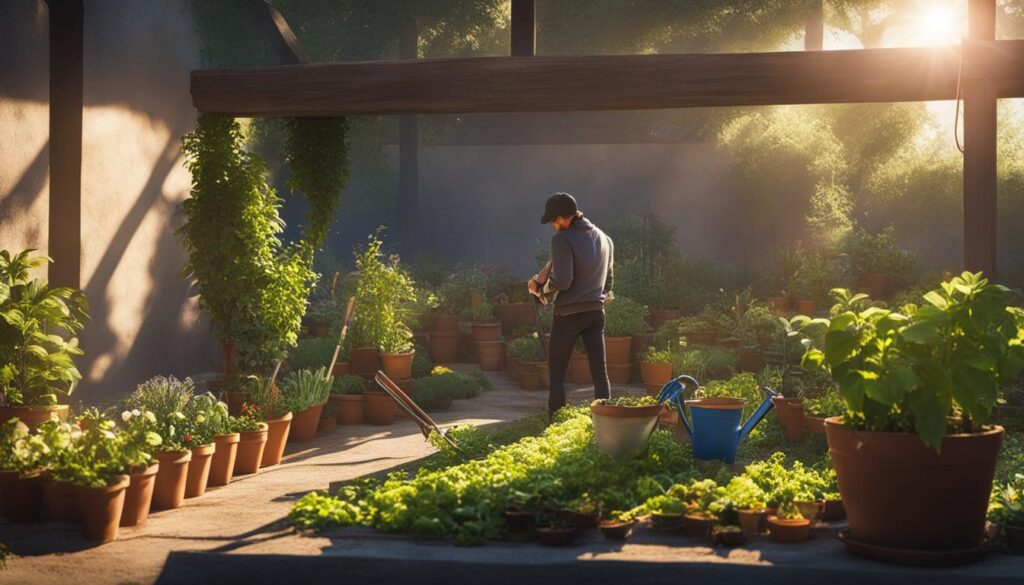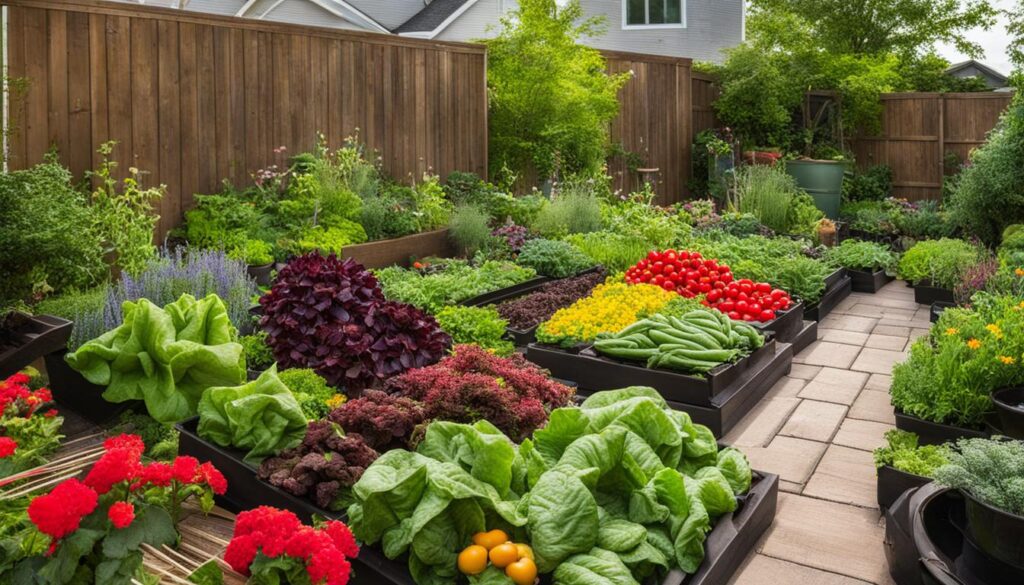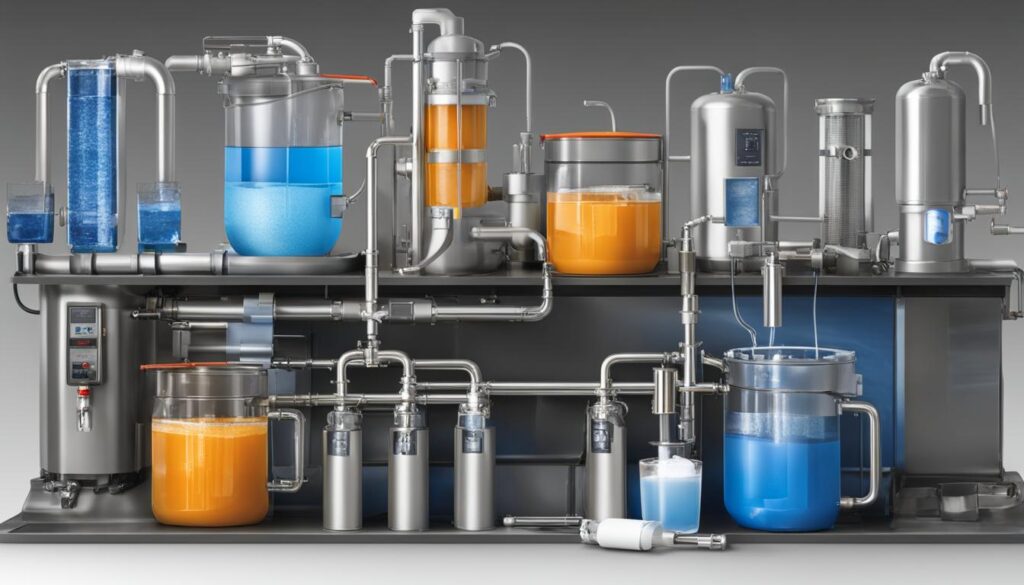
As someone who is passionate about preparedness and food security, I understand the importance of survival gardening in small spaces. In times of emergencies, having the ability to grow your own food can provide a much-needed source of nourishment and peace of mind. Whether you live in an urban apartment or have limited outdoor space, there are strategies and techniques that can help you cultivate a thriving garden. In this article, I will explore the benefits of survival gardening, provide practical tips for planning and maximizing productivity in small spaces, and offer innovative ideas for different living situations. Let’s dive in!
Key Takeaways:
- Survival gardening is essential for ensuring access to fresh and organic food during emergencies.
- Having a survival garden promotes self-sufficiency and food security in times of civil unrest or natural disasters.
- Proper planning and utilization of small-space gardening techniques are crucial for success.
- Apartment dwellers can create patio gardens or utilize hydroponic towers to overcome space limitations.
- Innovative ideas like companion planting and strategic positioning can maximize productivity in urban homes.
The Benefits of a Survival Garden
Having a survival garden offers numerous benefits. Not only does it provide a sense of self-sufficiency, but it also ensures food security in times of civil unrest, natural disasters, or food shortages. Additionally, growing your own food reduces your environmental footprint and promotes sustainable food production. It also allows you to have a constant supply of fresh and healthy produce.
When you cultivate a survival garden, you take control of your food source and create a self-sufficient lifestyle. No longer reliant on external food systems, you become more resilient and better equipped to handle emergencies or disruptions in the food supply chain. In times of crisis, your survival garden provides a reliable source of nourishment, offering peace of mind and alleviating concerns about food security.
Another significant benefit of a survival garden is its contribution to sustainable food production. By growing your own food, you reduce the demand for industrially produced, mass-marketed crops, which often rely on harmful pesticides, herbicides, and synthetic fertilizers. A survival garden allows you to adopt organic gardening practices, minimizing your impact on the environment and promoting a healthier ecosystem. It is a step towards a more sustainable and mindful approach to food production.
Moreover, a survival garden provides you with a continuous supply of fresh and nutritious produce. You have the freedom to choose the varieties of fruits, vegetables, and herbs that you prefer, ensuring a diverse and well-rounded diet. The satisfaction of harvesting your own crops and witnessing the fruits of your labor is unparalleled. Not only do you enjoy the delicious taste of homegrown food, but you also benefit from the increased nutritional value that comes with consuming freshly picked produce.
Self-Sufficiency and Food Security
A survival garden offers self-sufficiency and ensures food security in times of emergencies.
Growing your own food grants you independence and the ability to provide for yourself and your family. Whether it’s a short-term disruption or a long-term crisis, your survival garden acts as a crucial lifeline, offering sustenance and nourishment when other food sources may be scarce. Knowing that you have a reliable supply of fresh, homegrown produce instills a sense of confidence and resilience in the face of uncertainty.
Sustainability and Environmental Benefits
Growing your own food reduces your environmental footprint and promotes sustainable food production.
One of the essential benefits of a survival garden is its commitment to sustainability. By embracing organic gardening methods, you minimize the use of harmful chemicals and protect the environment from pollution. Additionally, homegrown produce requires less transportation, packaging, and energy consumption compared to store-bought alternatives, further reducing your carbon footprint.
A survival garden also enables you to practice sustainable water management by implementing techniques such as rainwater harvesting, graywater reuse, or drip irrigation systems. These methods conserve water and promote responsible water usage, contributing to a more sustainable lifestyle.
A Constant Supply of Fresh and Healthy Produce
A survival garden provides a continuous source of fresh and nutritious produce.
With a survival garden, you can enjoy the taste and benefits of fresh, homegrown vegetables and herbs all year round. Unlike store-bought produce, which may have traveled long distances and undergone extensive processing, your garden-fresh harvest retains more nutrients, vitamins, and flavor. By incorporating a variety of fruits and vegetables into your survival garden, you can create a diverse and well-balanced diet that promotes good health and well-being.
Additionally, the act of gardening itself offers numerous mental and physical health benefits. Spending time outdoors, engaging in physical activity, and connecting with nature are proven ways to reduce stress, improve mood, and enhance overall well-being. Tending to your survival garden becomes a therapeutic activity that nourishes not only your body but also your mind and soul.
Planning Your Small Space Garden
Proper planning is crucial when starting a small space garden. By following these steps, you can make the most of your available outdoor space and ensure a successful harvest.
Create a Garden Map
Begin by mapping out your small space garden. Take measurements of the area and identify any spots where planting is not feasible, such as walkways or areas shaded by buildings or trees. This will help you maximize the usable space and plan accordingly.
Embrace Small-Space Techniques
To optimize productivity in limited space, consider utilizing small-space gardening techniques such as square foot gardening. With this method, you divide your garden into smaller sections, each measuring one square foot, and plant different crops in each section. This allows you to grow a variety of vegetables in a compact area.
Maximize Sunlight Exposure
Most vegetables require at least 6 hours of sunlight per day for optimal growth. Therefore, it’s crucial to ensure that your garden receives sufficient sunlight. Observe your garden throughout the day to identify areas with the most sunlight and plan your planting accordingly. If certain areas receive less sunlight, opt for shade-tolerant plants or consider using artificial lighting for supplemental growth.
Learn Food Preservation Techniques
When planning your small space garden, it’s essential to think beyond the growing season. Learning food preservation techniques will help you extend the life of your harvested produce and ensure a continuous supply of homegrown food. Consider methods such as canning, freezing, and dehydrating to preserve your fruits, vegetables, and herbs for months to come.
Take a look at the table below for a comparison of different food preservation techniques:
| Preservation Technique | Benefits | Considerations |
|---|---|---|
| Canning | Long shelf life, preserves flavor and texture | Requires specialized equipment and careful sterilization |
| Freezing | Retains nutrients, easy and convenient | Requires freezer space, some vegetables may lose texture |
| Dehydrating | Compact storage, retains flavor for extended periods | Requires time, some loss of nutrients |

Planning your small space garden is the first step towards a bountiful harvest. By creating a garden map, embracing small-space techniques, maximizing sunlight exposure, and learning food preservation techniques, you can enjoy the benefits of homesteading and ensure a sustainable food source even in limited space.
Small Vegetable Garden Ideas for Apartment Dwellers
As an apartment dweller, you may face unique challenges when it comes to small-space gardening. However, with some innovative techniques, you can still enjoy the benefits of growing your own vegetables. Here are some small vegetable garden ideas that are perfect for apartment living:
Create a Patio Garden with Potted Plants
If you have a balcony or patio, it can be transformed into a vibrant garden space. Utilize potted plants to make the most of your limited space. Choose compact vegetable varieties that thrive in containers, such as cherry tomatoes, herbs like basil and mint, and leafy greens like lettuce and spinach. Arrange the pots strategically to optimize sunlight exposure, and don’t forget to water them regularly to ensure healthy growth.
Utilize Hydroponic Towers
Hydroponic towers are an excellent option for apartment dwellers who lack access to direct sunlight. These vertical systems allow you to grow vegetables hydroponically, meaning without soil, using nutrient-rich water. Hydroponic towers can be placed indoors near a window or even outdoors on a balcony or rooftop. You can grow a wide variety of crops, including lettuce, kale, peppers, and strawberries, in these space-saving towers. Enjoy fresh and nutritious produce right at your fingertips.
Benefits of Small-Space Gardening for Apartment Dwellers
“Small-space gardening is a game-changer for apartment dwellers. It allows us to connect with nature, grow our own food, and enjoy the benefits of urban gardening even in limited spaces. With patio gardens and hydroponic towers, we have the power to be self-sufficient and bring the joy of fresh produce into our homes.” – Michelle, Apartment Gardener
By implementing these small vegetable garden ideas, you can overcome the challenges of urban living and cultivate your own fresh and nutritious produce. Embrace urban gardening and enjoy the satisfaction of harvesting your own homegrown vegetables in the comfort of your apartment.
Innovative Small Vegetable Garden Ideas for Urban Homes
If you have a home in the city, there are several innovative ideas for small vegetable gardens that you can explore. These ideas can help you make the most of your limited space while still enjoying the benefits of fresh and homegrown produce.
1. Plant tall plants strategically
One strategy to optimize space in your small vegetable garden is to plant tall plants in the northernmost part. By doing so, you can reduce the shade they cast on other smaller plants, allowing them to receive ample sunlight for healthy growth. This method is particularly useful if your garden has limited access to direct sunlight.
2. Utilize raised garden beds
Raised garden beds are a fantastic solution for optimizing space and improving the quality of your soil. Not only do they provide better drainage, but they also allow for more efficient usage of nutrients. Additionally, raised beds can be designed at a height that is comfortable for gardening, reducing strain on your back and knees.
3. Explore companion planting
Companion planting is a technique where different plants are grown together, benefiting each other in various ways. Certain combinations of plants can repel pests, enhance pollination, and improve overall plant health. By implementing companion planting in your small garden, you can maximize the yield and productivity of your plants.
4. Experiment with vertical gardening
Vertical gardening is an excellent way to utilize vertical space in your urban home’s garden. You can create trellises or install climbing structures for plants such as tomatoes, cucumbers, or beans. Not only does vertical gardening help save space, but it also adds a visually appealing aspect to your garden.
5. Consider compact vegetable varieties
When space is limited, choosing compact vegetable varieties is a smart approach. Look for plants that are bred specifically for small spaces, such as bush-type tomatoes or compact peppers. These plants are generally more suitable for containers or smaller garden beds, allowing you to maximize the number of vegetables you can grow.
By implementing these innovative ideas, you can create a thriving vegetable garden in your urban home. Whether you have a small balcony, a rooftop, or a backyard, there are solutions that can help you embark on your urban gardening journey. Embrace the possibilities and enjoy the fresh taste of homegrown produce right at your doorstep.
Shady Vegetables for Your Small Garden Space
If your small garden space doesn’t receive much sunlight, don’t worry! There are still plenty of vegetables that thrive in shaded conditions, allowing you to make the most of your limited space.
Leafy Greens
Leafy greens are a fantastic choice for shady areas. They not only add vibrant green foliage to your garden but also provide essential nutrients. Consider planting the following leafy greens:
- Kale: Kale is a nutrient powerhouse, packed with vitamins and minerals. It tolerates shade well and can be grown throughout the year.
- Arugula: Arugula has a peppery flavor and is a great addition to salads. It grows well in partial shade and can be harvested within a few weeks of planting.
- Spinach: Spinach is rich in iron and other beneficial nutrients. It thrives in cooler temperatures and shade, making it perfect for your small garden.
Root Vegetables
Root vegetables are another excellent choice for shady spaces. These vegetables grow underground and require less direct sunlight. Try planting these root vegetables:
- Beets: Beets are not only delicious but also highly nutritious. They thrive in partial shade and can be harvested in as little as 50-60 days.
- Carrots: Carrots prefer cooler temperatures and can tolerate partial shade. They are a staple vegetable in many households and can be harvested within a few months of planting.
- Potatoes: Potatoes are versatile and can be grown in containers or in the ground. They can tolerate some shade and provide a bountiful harvest.
Brassica Vegetables
Brassica vegetables are known for their ability to tolerate shade. These plants offer a wealth of vitamins and minerals. Consider growing the following brassicas:
- Broccoli: Broccoli is a superfood packed with nutrients. It does well in partial shade and can provide a continuous harvest if properly cared for.
- Cabbage: Cabbage is a versatile vegetable that can be used in various dishes. It can tolerate shade and grows well in cool temperatures.
How to Start a Survival Garden
Starting a survival garden is a crucial step in emergency preparedness. When it comes to nourishing sustenance and ensuring a reliable food source during times of crisis, having your own garden can make all the difference. Whether you have a small backyard, a balcony, or even just a sunny windowsill, you can begin cultivating your own emergency food supply.
Before diving into the world of survival gardening, it’s important to determine your goals and the amount of food you aim to produce. Consider the number of people you need to feed and factor in your available time and resources to ensure realistic expectations. This will help you plan and allocate space accordingly.
Research is key in successful survival gardening. Look into organic gardening practices that prioritize soil health and sustainable growing techniques. Familiarize yourself with food preservation methods like canning, freezing, and drying, to ensure your fresh harvests can last longer. Don’t forget to explore seed saving techniques, which allow you to preserve and propagate the seeds from your own plants for future sowing.
Seeking advice from experienced gardeners can provide invaluable insights and shortcuts to success. They can guide you on crop selection, planting schedules, pest control, and other tips specific to your region or climate. Don’t hesitate to join local gardening communities or participate in online forums to connect with fellow garden enthusiasts.
When starting your survival garden, it’s important to make the most of the available space. Consider utilizing raised beds, vertical gardening techniques, and companion planting to optimize your garden’s productivity. This allows you to grow a greater variety of crops while conserving space.
Remember, a survival garden is not just a means of sustenance during emergencies, but also a source of joy and connection to nature. Get your hands dirty, feel the soil, and witness the miracle of seeds transforming into thriving plants. Gardening is a rewarding and therapeutic experience that can bring solace and fulfillment in any situation.

Key Takeaways:
- Determine your goals and the amount of food you aim to produce in your survival garden.
- Research organic gardening, food preservation, and seed saving techniques.
- Seek advice from experienced gardeners to leverage their knowledge and expertise.
- Optimize available space through raised beds, vertical gardening, and companion planting.
- Embrace the joy and therapeutic benefits of gardening, connecting with nature in the process.
Growing an Emergency Vegetable Garden on a Budget
Starting an emergency vegetable garden does not have to be expensive. There are several budget-friendly options available that can help you cultivate fresh produce without breaking the bank.
Utilize Recycled Containers or Repurposed Materials
One cost-effective way to create planters and raised beds for your emergency vegetable garden is by utilizing recycled containers or repurposed materials. Look around your home for containers such as old buckets, plastic bottles, or wooden crates that can be repurposed as planters. Not only does this help you save money, but it also promotes sustainability by reducing waste.
Consider Building a DIY Root Cellar
Building a DIY root cellar can provide an affordable solution for storing your harvested produce. A root cellar is a traditional storage method that helps extend the shelf life of root vegetables and other crops. By utilizing materials such as concrete blocks or even burying a cooler in the ground, you can create a cost-effective root cellar that will keep your vegetables fresh for an extended period.
“Utilize recycled containers or repurposed materials to create planters and raised beds.”
Embrace Sustainable Living Practices
Incorporating sustainable living practices into your emergency vegetable garden not only promotes self-sufficiency but also reduces your environmental impact. Implement strategies such as composting to create nutrient-rich soil for your plants. Use organic and natural methods to control pests and diseases, which can save you money on expensive chemical treatments.
Maximize Resources Through Resourcefulness
To create a thriving garden on a budget, it’s important to be resourceful. Seek out free or low-cost resources in your community, such as local gardening groups or seed exchanges. Save seeds from your own harvest for future plantings. Make use of rainwater by setting up a simple rain barrel system to irrigate your plants, reducing your water bill.
Budget-Friendly Gardening Tips
| Tip | Description |
|---|---|
| 1 | Repurpose containers or materials |
| 2 | Build a DIY root cellar |
| 3 | Embrace sustainable practices |
| 4 | Maximize resources through resourcefulness |
By implementing these budget-friendly gardening tips, you can create an emergency vegetable garden that is both cost-effective and sustainable. Enjoy the benefits of growing your own fresh produce while also being prepared for any unforeseen emergencies that may arise.
Cultivating a Connection to Nature Through Gardening
Gardening offers numerous benefits beyond food production. It provides a chance to connect with nature and engage in a fulfilling activity. Spending time in the garden has been shown to improve mental and physical well-being, reduce stress, and increase happiness. The act of caring for plants and watching them grow can bring a sense of joy and accomplishment. Gardening can truly be a therapeutic experience.
When we immerse ourselves in the process of gardening, we not only witness the miracles of nature but also become a part of it. The smell of fresh soil, the warmth of the sun on our skin, and the sound of birds chirping create a sensory experience that grounds us and reminds us of our connection to the natural world.
| Gardening Benefits | Mental and Physical Well-being | Connection to Nature | Stress Relief |
|---|---|---|---|
 |
Gardening has been proven to improve mental health by reducing symptoms of anxiety and depression. It provides a sense of purpose and accomplishment, boosting self-esteem and overall well-being. | Gardening allows us to reconnect with nature and appreciate its beauty. It reminds us of our place in the natural ecosystem and fosters a sense of respect and care for the environment. | The act of gardening has a calming effect on the mind and body. It reduces stress levels, lowers blood pressure, and promotes relaxation. Spending time in green spaces has also been linked to improved cognitive function and increased attention span. |
Maximizing Space and Productivity in Your Survival Garden
To make the most of your survival garden, I will share important strategies that will help you optimize space and increase productivity. By implementing these techniques, you can grow a bountiful harvest even in small areas.
Selecting the Right Crops
When space is limited, it is crucial to choose crops that are well-suited for small spaces. Opt for compact varieties that take up less room and can be grown in containers. Additionally, consider crops that can be grown vertically, such as vine plants or those that can be trained to grow on trellises. This way, you can make efficient use of your vertical space and increase your overall yield.
Utilizing Intensive Planting Techniques
Intensive planting is a powerful technique for maximizing yield in small spaces. Popular methods include square foot gardening and intercropping. Square foot gardening divides the growing area into small square sections, each dedicated to a specific crop. This maximizes space utilization and minimizes wasted areas. Intercropping involves planting complementary crops together to make efficient use of space and deter pests.
By adopting intensive planting techniques, you can grow a diverse range of crops in close proximity, promoting healthy plant growth and maximizing productivity.
Embracing Vertical Gardening
A vertical gardening system allows you to grow plants vertically, making great use of limited space. It is particularly useful for climbing plants like tomatoes, cucumbers, and beans. By utilizing trellises, stakes, or specially designed vertical structures, you can grow these plants upwards, saving horizontal space.
Vertical gardening not only maximizes space but also provides better air circulation and sunlight exposure for your plants, resulting in healthier growth and higher yields.
Emphasizing Space Optimization
Effective space optimization can significantly increase your overall productivity. Consider the layout of your garden and make sure to utilize every available nook and cranny. For example, utilize edges and borders for growing trailing plants or herbs. Use containers and hanging baskets to create a vertical garden on walls or fences. Be creative and think outside the box to maximize your growing space.
Integrating these techniques into your survival garden will allow you to grow more food in limited space, ensuring a sustainable and self-sufficient food source.
Conclusion
In conclusion, survival gardening is an essential aspect of emergency preparedness and self-sufficiency. It provides a reliable source of fresh food, ensuring that you have an emergency food supply even in challenging times. Whether you have a small balcony or a backyard, there are options available for growing your own food and becoming more self-reliant.
By implementing small space gardening techniques such as vertical gardening and utilizing hydroponic systems, you can effectively maximize productivity even in limited areas. Selecting suitable crops that are well-suited for small spaces and employing intensive planting methods like square foot gardening can further enhance your survival garden’s output.
Establishing a survival garden not only serves as a practical solution but also connects you with nature and provides a sense of fulfillment. Engaging in the nurturing process of plants and witnessing their growth is not only therapeutic but also promotes mental and physical well-being. Therefore, starting your survival gardening journey is a valuable investment towards a more self-sufficient and sustainable lifestyle.
FAQ
What is survival gardening?
Survival gardening, also known as a victory garden or war garden, is a way to supplement your food supply and ensure access to fresh and organic food. It is particularly important for preppers and those concerned about food security in emergencies.
What are the benefits of a survival garden?
Having a survival garden offers numerous benefits. It provides a sense of self-sufficiency and ensures food security during civil unrest, natural disasters, or food shortages. It also promotes sustainable food production, reduces environmental footprint, and provides a constant supply of fresh and healthy produce.
How do I plan a small space garden?
Proper planning is crucial for a small space garden. Start by creating a map of your available outdoor space, identify areas where you cannot plant, and consider techniques like square-foot gardening. Make sure your garden receives at least 6 hours of sunlight per day and learn about food preservation techniques.
What are some small vegetable garden ideas for apartment dwellers?
Apartment dwellers can create a patio garden with potted plants or utilize hydroponic towers that can be placed indoors or outdoors. These methods allow for growing vegetables even in the absence of direct sunlight. Planting vegetables in pots is also a viable option for maximizing produce in limited space.
What are some innovative small vegetable garden ideas for urban homes?
Urban homes can make use of strategies like planting tall plants in the northernmost part of the garden to reduce shade on other plants. Raised garden beds can also optimize space and improve soil quality. Companion planting, where different plants are grown together, is another effective technique for maximizing yield.
What vegetables thrive in shady conditions?
Leafy greens like kale, arugula, and spinach are perfect for shady areas and offer essential nutrients. Root vegetables such as beets, carrots, and potatoes can also be successfully grown in shady spaces. Brassica vegetables like broccoli and cabbage tolerate shade and provide a wealth of vitamins and minerals.
How do I start a survival garden?
Begin by determining your goals and the amount of food you aim to produce. Research organic gardening, food preservation, and seed saving techniques. Seek advice from experienced gardeners and utilize their knowledge. Start small and gradually expand your garden as you gain confidence and experience.
How can I start an emergency vegetable garden on a budget?
There are several budget-friendly options available. Utilize recycled containers or repurposed materials to create planters and raised beds. Consider building a DIY root cellar for storing harvested produce. Embrace sustainable living practices that minimize waste and promote self-sufficiency.
How does gardening benefit mental and physical well-being?
Gardening has been shown to improve mental and physical well-being, reduce stress, and increase happiness. Spending time in the garden, caring for plants, and watching them grow can bring a sense of joy and accomplishment. Gardening can be a therapeutic experience that allows you to connect with nature.
How can I maximize space and productivity in my survival garden?
Select crops that are well-suited for small spaces, such as compact varieties or those that can be grown vertically. Utilize intensive planting techniques, like square foot gardening or intercropping. Consider incorporating trellises or vertical structures to support climbing plants and make efficient use of vertical space.


